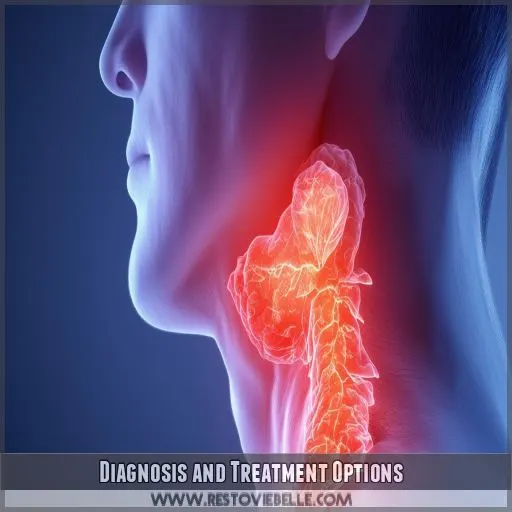This site is supported by our readers. We may earn a commission, at no cost to you, if you purchase through links.
 A lump on the back of your neck is often a cause for concern, but more often than not, it is harmless.
A lump on the back of your neck is often a cause for concern, but more often than not, it is harmless.
This could be as minor as an ingrown hair or a swollen lymph node.
In this article, we will explore the most common reasons why a lump may appear in this area, as well as the signs to look out for and how to go about getting a diagnosis and treatment. We will also advise on when it is necessary to seek medical attention.
Read on to find out more and alleviate your worries if you have noticed a lump on the back of your neck.
Table Of Contents
- Key Takeaways
- Lump on Back of Neck Overview
- Common Causes of Neck Lumps
- Symptoms and Signs to Watch For
- When to Seek Medical Advice
- Diagnosis and Treatment Options
- Frequently Asked Questions (FAQs)
- When should I worry about a lump behind my neck?
- What does a neck cancer lump feel like?
- What is this lump behind my neck hairline?
- What is a cyst on the back of the neck?
- What are possible symptoms of a neck lump?
- When is it necessary to see a doctor about a neck lump?
- What are the potential causes of a neck lump?
- How does a doctor diagnose a neck lump?
- What treatment options exist for a neck lump?
- Conclusion
Key Takeaways
- Don’t panic if you find a lump – most are as harmless as a pussycat. But keep an eye on that little bugger and jot down any changes.
- If your lump’s causing more drama than a soap opera – pain, difficulty swallowing, or playing hide and seek with your breathing – it’s time to call in the pros.
- Your doc’s got more tricks up their sleeve than a magician to figure out what’s going on. From playing doctor with a physical exam to high-tech scans, they’ll get to the bottom of it.
- Treatment’s not one-size-fits-all. Depending on what’s causing your neck’s unexpected guest, you might be popping antibiotics, going under the knife, or zapping it with radiation. Your doc will help you pick your poison.
Lump on Back of Neck Overview
A neck lump can vary in location, size, texture, and duration. It can be as small as a pea or large enough to be noticeable. The texture may range from soft and movable to hard and fixed. Neck lumps can develop suddenly and disappear on their own, or they may persist and even grow over time.
Pay attention to any accompanying symptoms, such as pain, tenderness, difficulty swallowing, or changes in your voice. Swollen lymph nodes are a common cause of neck lumps, especially if you’re fighting an infection. However, neck lumps can also be a sign of something more serious, like head and neck cancer. If you notice any persistent or concerning lumps, it’s important to consult an ENT specialist for an accurate diagnosis and appropriate treatment.
Common Causes of Neck Lumps
Neck lumps can arise from swollen lymph nodes, cysts, boils, or allergic reactions. Understanding these common causes can help you identify the underlying issue and seek appropriate treatment.
Swollen Lymph Nodes
Swollen lymph nodes are a common cause of neck lumps. Lymph nodes are part of your body’s drainage system, helping your immune system fight off infections. Several lymph nodes run along the back of your neck.
A swollen lymph node typically feels like a tender, marble-sized, movable lump. They can swell due to a nearby infection or for no apparent reason.
Cysts
Another common cause of neck lumps is cysts—nodules under the skin that contain keratin. Most cysts are benign and painless, but they can become infected and resemble large pimples. Cysts may come and go, or they might grow larger over time. If you have a cyst, your doctor can easily remove it in the office.
Boils
Boils are localized infections that often appear as red, painful bumps. They can develop from cysts, acne, or blocked hair follicles. While it may be tempting to squeeze them, doing so can actually worsen the infection. Instead, focus on these strategies:
- Apply warm compresses to alleviate pain and draw the infection out.
- Manage pain with over-the-counter medications like ibuprofen or acetaminophen.
- Consult your doctor about antibiotics to clear the infection.
Allergic Reactions
Allergic reactions and skin irritation can lead to lumps on the back of your neck. This could be due to sensitivity to shampoo, hair care products, detergent, or sunscreen. Friction from clothing can also cause a rash or itchy lump. Try changing your detergent, keeping your neck clean, and reducing the number of products you use on your skin and hair. If the issue persists, see a doctor, who may test for allergies or examine the rash.
| Potential Allergens | Symptoms | Treatment |
|---|---|---|
| Shampoo | Itchy lump | Change shampoo |
| Detergent | Rash | Change detergent |
| Sunscreen | Dry patches | Reduce use |
| Clothing | Friction | Wear looser clothing |
| Insect bite | Red, itchy bump | Apply anti-itch cream |
Symptoms and Signs to Watch For
If your neck lump is painful or tender, or if it’s causing difficulty swallowing or breathing, these are signs you should see a doctor. Changes in the size or shape of the lump are also a reason to get it checked out.
Pain or Tenderness
If you notice a lump on the back of your neck that’s causing pain or tenderness, it’s important to pay attention to other symptoms and take action. Here are some key things to watch for:
- Persistent or worsening pain.
- Discomfort when moving your neck or swallowing.
- Any other unusual symptoms, such as fever, weight loss, or night sweats.
Difficulty Swallowing or Breathing
If you’re experiencing difficulty swallowing or breathing, along with a lump on the back of your neck, it’s imperative to heed these warning signs. These symptoms could indicate a more serious underlying issue, especially if you’re also noticing other changes, such as unexplained weight loss.
| Symptom | Potential Cause | Action |
|---|---|---|
| Difficulty swallowing | Enlarged lymph nodes | See an ENT specialist |
| Difficulty breathing | Compressed airway | Seek immediate medical attention |
| Unexplained weight loss | Infection or tumour | Consult your doctor |
| Persistent or growing lump | Potential cancer | Schedule a biopsy |
Difficulty swallowing or breathing could be a sign of enlarged lymph nodes pressing on your windpipe or oesophagus. It’s important to see a nose and throat (ENT) specialist to determine the cause and rule out anything serious.
Changes in the Lump
If you notice any changes in the lump on the back of your neck, such as:
- Size and consistency: If the lump grows larger, changes shape, or becomes harder over time.
- Colour: Any discoloration or redness around the lump.
- Duration: How long the lump has been present and if it comes and goes.
These changes could indicate the need for further evaluation by a medical professional, especially if they’re persistent or accompanied by other symptoms.
Here are some additional signs to watch for:
- Location: The location of the lump in relation to other structures, such as the thyroid or salivary glands.
- Congenital neck masses: Some people are born with neck lumps, which can be benign or require medical attention.
- Medical oncologists’ advice: If you’re concerned about a persistent lump, it’s important to consult a doctor, especially if you have a personal or family history of cancer.
When to Seek Medical Advice
If you notice a lump on the back of your neck that’s persistent or growing, it’s time to see a doctor. Also, seek medical advice if you have other symptoms like difficulty swallowing, pain, or if the lump is near critical structures such as your thyroid or salivary glands.
Persistent or Growing Lump
If you notice a persistent or growing lump on the back of your neck, it’s important to seek medical advice, especially if it’s been there for a while. Factors like size, location, age, and duration matter when deciding whether to see a doctor. Don’t ignore lumps that stick around or keep reappearing.
Accompanying Symptoms
Besides noticing a persistent or growing lump on the back of your neck, there are other symptoms you should be aware of that may indicate a more serious underlying issue:
- Difficulty swallowing
- Difficulty breathing
- Hoarseness
- A hard lump
- A fixed lump
If you experience any of these additional symptoms, it’s important to consult a doctor as soon as possible.
Location Near Vital Structures
While the location of a neck lump may not always suggest a serious condition, it’s imperative to acknowledge its proximity to critical structures. If a lump is near certain areas, it may warrant medical examination due to potential concerns.
| Lump Location | Critical Structures Nearby | Reasons for Examination |
|---|---|---|
| Near Thyroid | Thyroid Gland | Hormonal Regulation |
| Near Salivary Glands | Salivary Glands | Swallowing, Digestion |
| Near Carotid Artery | Major Blood Vessel | Blood Flow to Brain |
| Near Nerves | Spinal Cord, Brain | Sensory and Motor Function |
Therefore, when a lump appears on the back of your neck, it’s essential to acknowledge not only the lump’s characteristics but also its location in relation to these critical structures.
Diagnosis and Treatment Options
To diagnose a lump on the back of your neck, your doctor will perform a physical exam and may order tests like biopsies, blood tests, or imaging scans. Treatment options range from antibiotics for infections to surgical removal, with more severe cases requiring radiation or chemotherapy.
Physical Examination
If you notice a persistent or growing lump on the back of your neck, or if it’s accompanied by other symptoms, it’s important to see your doctor.
They’ll perform a physical examination, which may include feeling the lump and checking for tenderness or pain.
They’ll also take your medical history and may recommend further tests to determine the cause and decide on the best treatment.
Biopsy, Blood Tests, Imaging
A doctor may recommend a biopsy, where they remove a small sample of cells from the lump for examination under a microscope. Blood tests can help identify underlying infections or conditions, while imaging tests like CT scans or MRIs provide detailed visuals of the lump to aid diagnosis.
Antibiotics, Surgery, Radiation, Chemotherapy
Treatment options for a lump on the back of your neck depend on the underlying cause.
Antibiotics are typically used to treat bacterial infections. However, antibiotic resistance is a growing concern.
Surgery is another option, but it carries potential side effects such as scarring and infection.
Radiation therapy and chemotherapy are more aggressive treatments with their own set of risks, including radiation exposure and chemotherapy success rates, respectively.
Alternatively, observation may be considered for small, benign lumps.
Frequently Asked Questions (FAQs)
When should I worry about a lump behind my neck?
You should see a doctor about a lump on the back of your neck if it’s persistent, growing, or accompanied by other symptoms like pain or difficulty swallowing.
What does a neck cancer lump feel like?
Cancerous lumps in the neck are often described as hard, not squishy. They can range from a half-inch to several inches in diameter. Thyroid cancer tumours in the neck can feel like small solid or fluid-filled growths.
What is this lump behind my neck hairline?
A lump behind your neck hairline could be a swollen lymph node, cyst, ingrown hair, or skin irritation. It’s usually nothing serious, but see a doctor if you’re concerned.
What is a cyst on the back of the neck?
A cyst on the back of the neck could be a sebaceous cyst or a branchial cleft cyst. While they’re usually painless, cysts can become infected and resemble large pimples. They may require medical treatment.
What are possible symptoms of a neck lump?
Symptoms of a neck lump include difficulty swallowing, a persistent cough, sore throat, earache, fever, and pain in the ears or throat. A neck lump may be a sign of thyroid cancer.
When is it necessary to see a doctor about a neck lump?
Don’t let your neck become a ticking time bomb. See a doctor if the lump persists, grows, or causes pain. It’s imperative to get checked when you’ve got difficulty swallowing, breathing issues, or unexplained weight loss.
What are the potential causes of a neck lump?
Neck lumps can be caused by swollen lymph nodes, infections, cysts, or benign growths. In rare cases, they’re linked to cancer. The location and characteristics of the lump often provide clues to its cause.
How does a doctor diagnose a neck lump?
Like a detective unraveling a mystery, your doctor’ll delve into diagnosing your neck lump. They’ll examine it, ask about symptoms, and may order tests like blood work, imaging scans, or a biopsy to pinpoint the cause.
What treatment options exist for a neck lump?
Treatment options for neck lumps vary based on the cause. You might need antibiotics for infections, surgery for benign growths, or radiation and chemotherapy for cancer. Your doctor will determine the best approach after diagnosis.
Conclusion
Knowledge empowers you regarding your health. If you’ve discovered a lump on the back of your neck, remain calm. Most are harmless, but it’s essential to track any changes.
Monitor for pain, swelling, or difficulty breathing. If the lump persists or grows, consult your doctor. They’ll examine it and may recommend tests for an accurate diagnosis.











